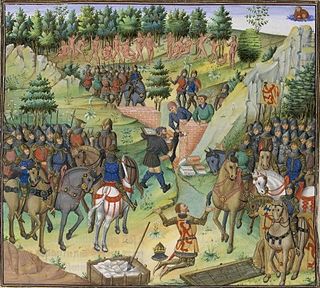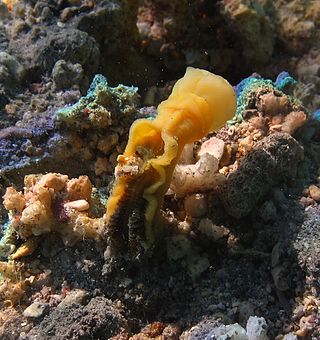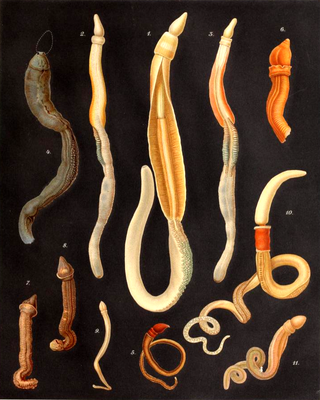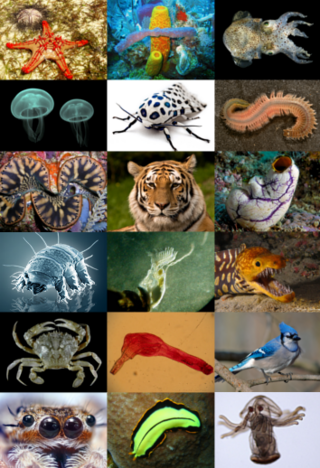Related Research Articles

Hemichordata is a phylum which consists of triploblastic, enterocoelomate, and bilaterally symmetrical marine deuterostome animals, generally considered the sister group of the echinoderms. They appear in the Lower or Middle Cambrian and include two main classes: Enteropneusta, and Pterobranchia. A third class, Planctosphaeroidea, is known only from the larva of a single species, Planctosphaera pelagica. The class Graptolithina, formerly considered extinct, is now placed within the pterobranchs, represented by a single living genus Rhabdopleura.

Termites are a group of detritophagous eusocial insects which consume a wide variety of decaying plant material, generally in the form of wood, leaf litter, and soil humus. They are easily identified by the soft-bodied and typically unpigmented worker caste for which they have been colloquially termed "white ants"; however, they are not ants to which they are distantly related. About 2,972 extant species are currently described, 2,105 of which are members of the family Termitidae.

Graptolites are a group of colonial animals, members of the subclass Graptolithina within the class Pterobranchia. These filter-feeding organisms are known chiefly from fossils found from the Middle Cambrian through the Lower Carboniferous (Mississippian). A possible early graptolite, Chaunograptus, is known from the Middle Cambrian. Recent analyses have favored the idea that the living pterobranch Rhabdopleura represents an extant graptolite which diverged from the rest of the group in the Cambrian. Fossil graptolites and Rhabdopleura share a colony structure of interconnected zooids housed in organic tubes (theca) which have a basic structure of stacked half-rings (fuselli). Most extinct graptolites belong to two major orders: the bush-like sessile Dendroidea and the planktonic, free-floating Graptoloidea. These orders most likely evolved from encrusting pterobranchs similar to Rhabdopleura. Due to their widespread abundance, plantkonic lifestyle, and well-traced evolutionary trends, graptoloids in particular are useful index fossils for the Ordovician and Silurian periods.

Gog and Magog appear in the Bible and the Quran as individuals, tribes, or lands. In Ezekiel 38, Gog is an individual and Magog is his land; in Genesis 10, Magog is a man and eponymous ancestor of a nation, but no Gog is mentioned; by the time of Revelation 20:8 Jewish tradition had long since changed Ezekiel's "Gog from Magog" into "Gog and Magog".

The Calliphoridae are a family of insects in the order Diptera, with almost 1,900 known species. The maggot larvae, often used as fishing bait, are known as gentles. The family is known to be polyphyletic, but much remains disputed regarding proper treatment of the constituent taxa, some of which are occasionally accorded family status.

Balanoglossus is a genus of ocean-dwelling acorn worms (Enteropneusta). It has zoological importance because, being hemichordates, they are an "evolutionary link" between invertebrates and vertebrates. Balanoglossus is a deuterostome, and resembles the sea squirts (Ascidiacea) in that it possesses branchial openings, or "gill slits". It has a notochord in the upper part of the body and has no nerve chord. It does have a stomochord, however, which is a gut chord within the collar. Their heads may be as small as per 2.5 mm (1/10 in) or as large as 5 mm (1/5 in).

The acorn worms or Enteropneusta are a hemichordate class of invertebrates consisting of one order of the same name. The closest non-hemichordate relatives of the Enteropneusta are the echinoderms. There are 111 known species of acorn worm in the world, the main species for research being Saccoglossus kowalevskii. Two families—Harrimaniidae and Ptychoderidae—separated at least 370 million years ago.

Animals are multicellular, eukaryotic organisms in the biological kingdom Animalia. With few exceptions, animals consume organic material, breathe oxygen, are able to move, can reproduce sexually, and grow from a hollow sphere of cells, the blastula, during embryonic development. As of 2022, 2.16 million living animal species have been described—of which around 1.05 million are insects, over 36,000 are fishes, around 11,700 are reptiles, over 11,100 are birds, and 6,596 mammals—but it has been estimated there are around 7.77 million animal species in total. Animals range in length from 8.5 micrometres (0.00033 in) to 33.6 metres (110 ft). They have complex interactions with each other and their environments, forming intricate food webs. The scientific study of animals is known as zoology.

Ambulacraria, or Coelomopora, is a clade of invertebrate phyla that includes echinoderms and hemichordates; a member of this group is called an ambulacrarian. Phylogenetic analysis suggests the echinoderms and hemichordates separated around 533 million years ago. The Ambulacraria are part of the deuterostomes, a larger clade that also includes the Chordata, Vetulicolia.

Saccoglossus is a genus of acorn worm. It is the largest genus in this class, with 18 species.

Ptychoderidae is a family of acorn worms.
Mesoglossus intermedius is a species of acorn worms in the family Harrimaniidae, which is endemic to Northern California.
Paleontology or palaeontology is the study of prehistoric life forms on Earth through the examination of plant and animal fossils. This includes the study of body fossils, tracks (ichnites), burrows, cast-off parts, fossilised feces (coprolites), palynomorphs and chemical residues. Because humans have encountered fossils for millennia, paleontology has a long history both before and after becoming formalized as a science. This article records significant discoveries and events related to paleontology that occurred or were published in the year 2016.
Cornelius Jan van der Horst was a Dutch biologist who worked mainly on marine biology and embryology in both the Netherlands and South Africa. As an undergraduate he studied botany and zoology at the University of Amsterdam where he was appointed assistant in the Botany Department under Professor Dr Hugo de Vries before moving on to assist Max Wilhelm Carl Weber at the University's Zoological Museum and in 1917 he became the principal assistant for general Zoology. In 1916 he published his thesis De motorische kernen en banen in de hersenen der visschen. Hare taxonomische waarde en neurobiotactische beteekenis. The research for this thesis was carried out at the Netherlands Central Institute for Brain Research under C. U. Ariëns Kappers. In 1925 Van der Horst was appointed Deputy Director of this Netherlands Central Institute for Brain Research and in 1928 he moved to South Africa where he took up a post as senior lecturer in zoology at the University of the Witwatersrand in Johannesburg. in 1932 he was promoted to professor in zoology at this University.
Stereobalanus is a genus of acorn worms belonging to the family Harrimaniidae.
Mesoglossus is a genus of worms belonging to the family Harrimaniidae.
Ritteria is a monotypic genus of worms belonging to the family Harrimaniidae. The only species is Ritteria ambigua.
References
- ↑ A taxonomic revision of the family Harrimaniidae (Hemichordata: Enteropneusta) with descriptions of seven species from the Eastern Pacific. 2010. PDF
- ↑ A taxonomic revision of the family Harrimaniidae (Hemichordata: Enteropneusta) with descriptions of seven species from the Eastern Pacific
- ↑ Halanych, Kenneth M.; Bernt, Matthias; Cannon, Johanna T.; Tassia, Michael G.; Kocot, Kevin M.; Li, Yuanning (2019-01-01). "Mitogenomics Reveals a Novel Genetic Code in Hemichordata". Genome Biology and Evolution. 11 (1): 29–40. doi:10.1093/gbe/evy254. PMC 6319601 . PMID 30476024.
- ↑ Harrimaniidae World Register of Marine Species. Retrieved October 17, 2011.